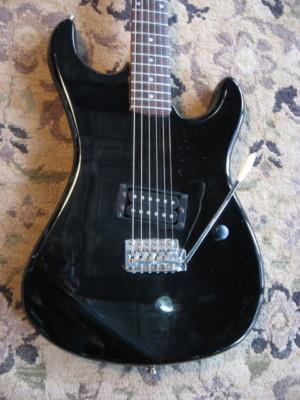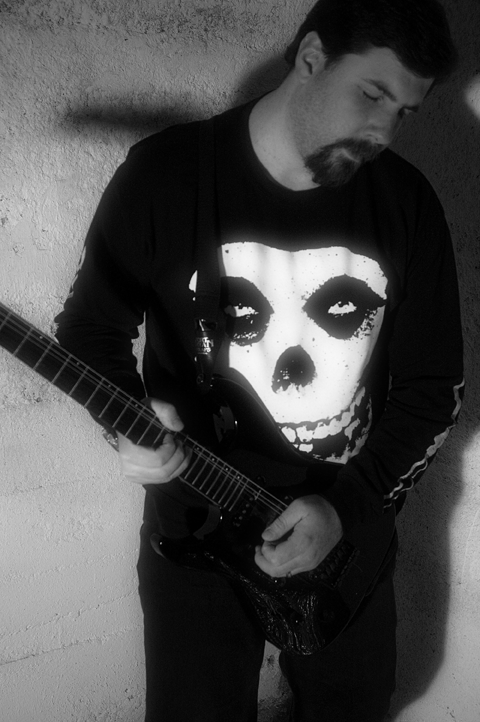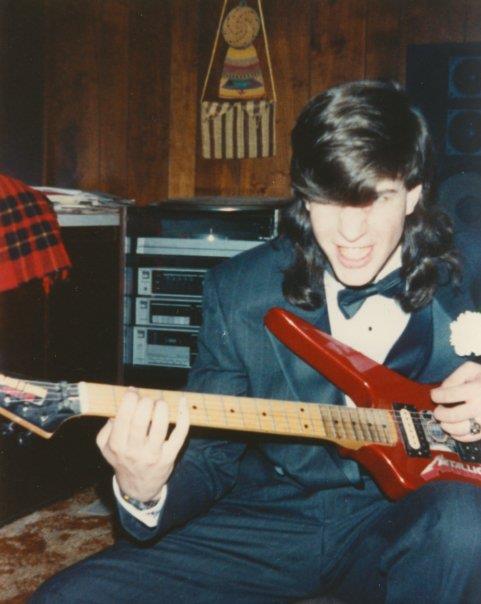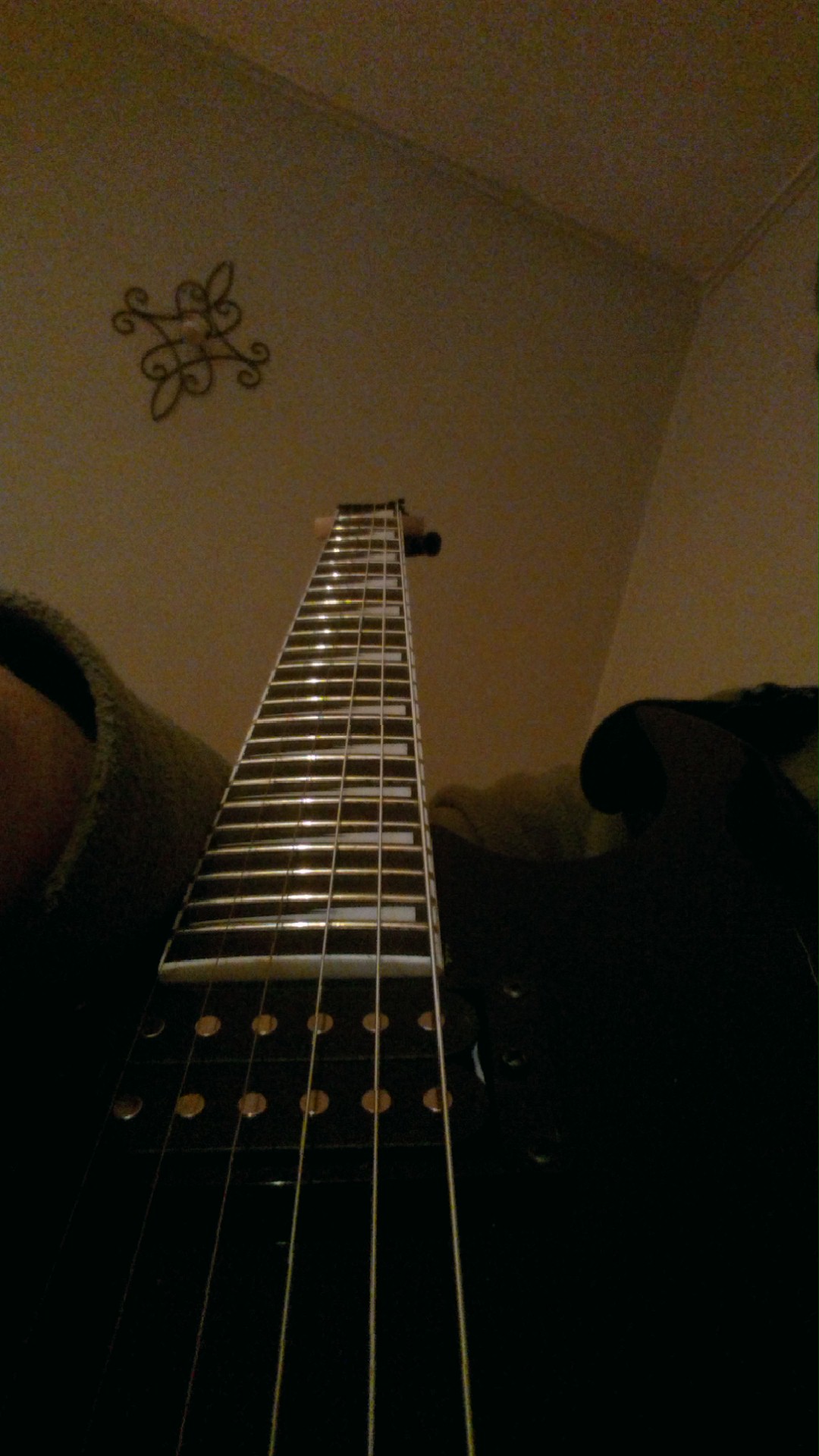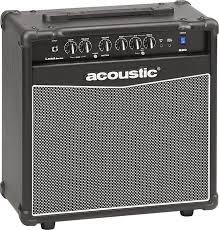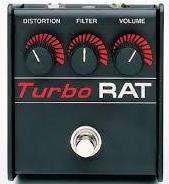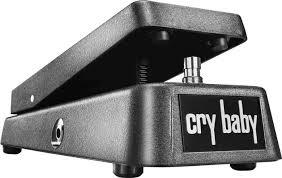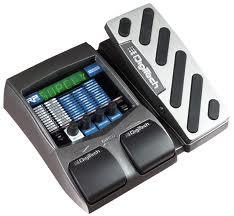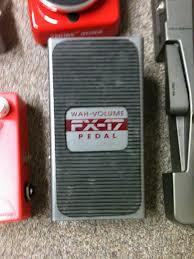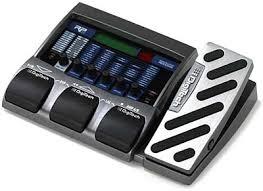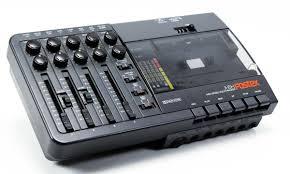the phil ware experience's gear
1987 - 1989 - Kramer Aerostar ZX10
I'm not sure I have photographic proof of ever having used this guitar, but it was a decent enough axe for $179, purchased at Alpha Music in Norfolk, Va. It was black with a single, angled humbucker and a fairly useless tremolo. Here's a stock photo...swiped from eBay. Hopefully, it doesn't disappear, because there aren't a heck of a lot of photos out there.
1989 - 1993 - Kramer Condor Custom
Picked up for about $99 from Bay Music with a trade in for the above Aerostar, this beast of horrifying electronics and suspect acoustics was my mainstay for quite a while. The humbuckers were pretty solid, high-output and quiet-ish. What wasn't quiet was that when you moved the guitar, you could hear the tremolo bar and bridge "klang" through the amp. Not as awesome as you would think, really. Because finding a picture of my playing this is fairly rare -- I have one or two that I need to scan, but in the meantime...let's recycle.
If I still had this instrument, I could probably bring it up to spec pretty easily, now. That said, I traded it for something. I don't remember what...
Guitars
1993 - Present - Jackson Stealth EX
My first honest to goodness left-handed instrument, this guitar is still very much in use, today. Picked up while in college, but still from Alpha Music -- they treat you well! -- I've recorded a LOT of demos and assorted noise with this guitar. It's received a lot of dings along the road, but it's also old enough to drink, so I guess over the course of 21+ years, that's to be expected.
Started in 2012, and finished in 2013, I replaced the jack with a stereo jack, replaced the 5-way switch and replaced the high-output Jackson stock humbucker and singles with Seymour Duncan Blackout active pickups (AHB-1, AS-1, AS-1N). Since then, I have endeavored to lock down the Jackson Floyd Rose licensed tremolo and have removed the locking nut nuts. I then added locking tuners and enjoy them, immensely. At some point, I will look at replacing the bridge, or at least the saddles, though I'd give my eye-teeth for a fixed bridge on this axe. Actually, over the holidays, I got that taken care of with a Tremol-No. I recommend them, highly.
This will be sporting QPart red acrylic dome knobs. Lower profile, I like how they feel and, more importantly, I like how they look.
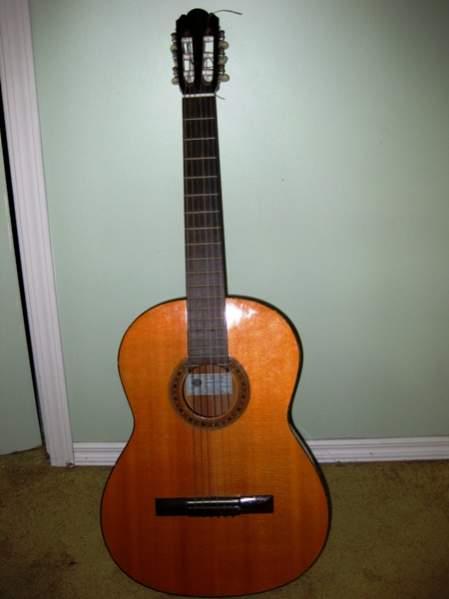
1995 - Present - Epiphone Entrada EC-15
This is why you never underestimate what Goodwill has to offer. I've seen these on eBay for over $300. I paid $40 at a Richmond, Va Goodwill. This is a gorgeous instrument and one on which I've written a lot of music.
I replaced the tuners a while back, but need to do so, again, and this time get actual, honest to goodness classical tuners that aren't, well, really cheap. Additionally, sometime in the very near future, I will be replacing the nut with a left-handed one, probably Tusq, and giving the instrument a left-handed bridge saddle, since it hasn't had one since I purchased it. (What's that *buzz?!*)
2013 - Present - Ibanez Gi0
A lesson in "cheap," the GRG120BDXL was added to fold to allow me to do at least some form of recording while I finished the pickup replacement on the Jackson. That said, it epitomizes "cheap" rather than "inexpensive."
What I like:
The pickups are high-output and don't sound horrible, just a little muddier than the Blackouts or Schecter pickups. The neck is a good scale and feels comfortable in the hand. I do like the Ibanez body and headstock shapes.
What I don't like:
The bridge is horiffic. Specifically, the hardware is sharp and for playing any palm-muting at all, it cuts into the flesh of the palm causing a bloody mess after some good riffing. Worse? The sharp allen-screws also catch in the palm and unscrew themselves, thus throwing you out of tune.
The frets were unfinished. Seriously. I have a photo of how chafed and bleeding my fret hand was after the first week of playing this guitar. They extend beyond the very cheap plastic neck binding and take about a solid month to wear down without going after them with a file.
The knobs are the cheapest I've ever seen, and that includes the First Act guitar Connor bought himself when he was 10. The tuning heads are almost as cheap as the knobs.
So, bottom line -- it's a passable instrument, but I have a very guarded relationship with it and use it sparingly because of the lack of quality parts (which will be replaced as money permits) and pointy, pokey hardware that makes it painful to play.
The ultra-cheap knobs have been replaced with QParts blue pearl acrylic dome knobs. Definitely classes up the joint.
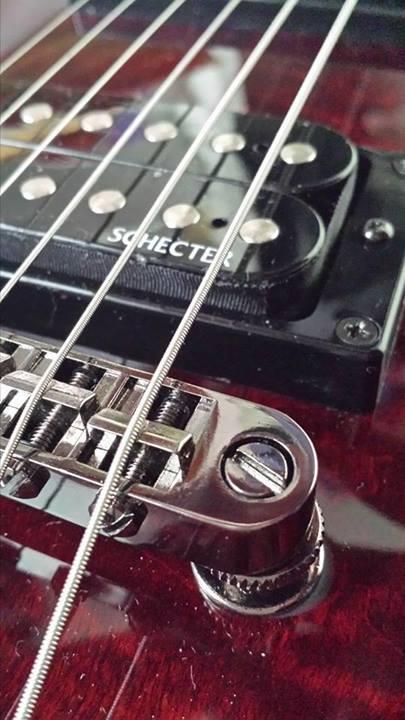
2014 - Present - Schecter Omen
Extreme 6 Diamond
Series
And it came that the purchase of a new guitar was not only sanctioned, but encouraged, I went to the local store, Carlin Music, and walked out with a left-handed Schecter. It's gorgeous and it plays like a dream.
Being 25.5" scale, it feels more comfortable than even the Jackson, and less crowded when doing tight clumps of notes..
The pickups are bright and lend themselves to metal, but also seem to have enough "quack" even when not coil split, to play some good blues or jazz.
I love the resonance of the body. This instrument, despite being kind of low on the Schecter food chain, has sustain to burn.
I mentioned being on Schecter's "lower end," model-wise. Don't take that to follow in the footsteps above. Everything about this instrument screams quality parts and construction. Now, to get it involved in the recording process.
Oh, and I know the pic is high-arty, but taken with my phone, I find it gorgeous and representative of the instrument.
Swapped out the knobs with green abalone shell topped dome. They compliment very well.
Amps
1987 - 1990 - Sanyo HiFi stereo
OK, so when the first Kramer came home, there were no cables, no effects and, as would follow, no amps in sight. What we did have was a component stereo system that was pretty high-end for it's time and, anecdotally, still in use, today, even though it's roughly 32 years old.
It had a decent solid state amp that could push out some volume, let me tell you.
The notable part of this was that it had a single tape transport with stereo inputs and split input level knob. Pretty advanced stuff and a very, very solid mechanism by which to record -- which it was necessary to do, otherwise you couldn't use the monitor function and actually hear what you were playing.
1990 - 1995 - Stone GS 10
A nice 10W amp that played well enough. It helped magnify the horrible electronics involved with the Condor and helped produce some sequeally demos during the college years.
It had a single input and output, so I generally used a Y-Connector from Radio Shack to allow my stereo effects to not sound weird with a mono amp.
It played well with all of my effects, even the QuadraverbGT, so that made me happy. Then the solid-stateness gave out and it came time to replace it.
1995 - 2004 - '89 Marshall Tweed Micro-stack
Bought off of local Richmond metal act Claude Zircle's guitarist, Mike Trimble, this served me well and I loved this amp. It wasn't perfect, but it has volume and just looked sweet.
What it didn't do was play well with the QuadraverbGT. For whatever reason, it never really translated any of my distortion properly and, often, sounded muddy. One of my sorrows is that I needed to part with it before getting the Digitiech RP-series effects in line to play through it, since I hazard I would have better control over the tone.
2013 - Present - Acoustic Lead-Series G20
This amp gives you 20W of ear-splitting joy. I haven't taken it past 2, yet, volume-wise. It's a solid amp that represents, faithfully, the tone from the effects unit as well as just the instrument, so I just plug in the guitar and go. The Lead/Chrunch settings are perfect even for just plugging in. The tone is excellent and faithful to the instrument.
My only kibitz with this amp is that it only has a 1/8" out (earphones - as I still make a differentiation between "ear"- and "head"-phones, which utilize a 1/4" connector), most of the time. At any rate, *that* is my kibitz. Other than that, this is a very solid and usable amp.
Effects
~1987 - 1990 - Ibanez LA Metal Pedal
Crunchy and fuzzy and annoying -- but in a good way. I epitomized the Ratt / Motley Crue sound from about 1985. I, personally, didn't find it versatile enough, so it got paired (taking a page from Gary Holt's book...) with another distortion pedal, listed below, the TurboRat.
1988 - 1993 - Boss CH-1 Super Chorus
I loved this pedal, but it ate batteries faster than it was possible for a poor college kid to keep up. The versatility was awesome and I actually wrote an intro to a song with it that I haven't been able to, adequately, duplicate with any effects processor since.
1990 - 2001 - ProCo Turbo Rat
A work horse and a powerhouse, this pedal did me well for many a year until it finally didn't. I used this as my mainstay distortion for many years and even spent a few months using it in conjunction with the LA Metal pedal to give just a horrifying distorted sound that would, as I would find out, become a stable in death and extreme metal bands. That said, it was perfect for the thrash I was playing. Then, it died.
1990 - Present - Dunlop Crybaby Wah
I have actually owned two of these. The first was second-hand and, apparently, I used the heck out of it, because it eventually refused to output any sound regardless of the freshness of the battery or the number of goats I sacrificed. I enjoyed the tone and still use one, today, to augment the wah on my effects processor.
1993 - 2005 - Alesis QuadraVerbGT
Paired with a DigiTech PCM10 foot controller, this beast provided some of my favorite tones, ever, and it was with great sorrow that it burned out its power supply and at the time a replacement power supply would have cost more than a new multi-effects processor. An exceptionally versatile tool, I had 20 tried and true settings that ranged from face-melting to surreal. The only problem was that it and the Marshall amp never saw eye to eye on how distortion should sound. Actually, to be blunt, it and *I* never saw eye to eye. It had many strong points but distortion sounded kind of fake. I'd still use my TurboRat for most of that until the TurboRat gave up the ghost. Still, many a demo were recorded with this beast and many an hour have been spent with new multi-effect processors trying to replicate the sounds I could get out this beastie.
2005 - 2010 - DigiTech RP250
"Do it on the floor." This was the ad campaign. Nice, right? Well, lucky for them I didn't see the ad until after I purchased this replacement for the QuadraVerb. A very servicable and mostly rugged unit, I customized the heck out of the sounds and tones and everything I could on this. It has some pretty solid tones and a myriad customizations.
The built-in expression pedal was nice and allowed more customizations than my standard CryBaby.
The jacks loosened up after a bit, but that's basically my only complaint with this unit.
2006 - 2007 - DOD FX-17 Wah-Volume
For whatever reason, I decided to roll with one of these instead of my CryBaby. When the first CryBaby died, I picked this up. Actually, it's a solid little pedal. The problem that I encountered was that when it finally gave up the ghost, it did so unequivocaily. It caught on fire.
2010 - Present - DigiTech RP350
During moves, the RP250 went MIA. This was a problem and so, it became necessary to find something to replace it and the RP350 was the best bang for the buck. It basically has everything from the RP250 plus USB and it came with DAW software. I believe it was Cubase, which I still use occasionally.
My mainstay for recording, I have some pretty solid settings that I feel would fall under the "tried and true" settings. The big challenge has been getting settings that offer the same, if not tone, then basic *feel* across the instruments. The a/b amp pedal helps with that a lot.
My only real complaint is that the USB, when recording straight USB-in has some latency issues -- roughly 37ms, if I remember correctly. Thankfully, the M-Audio MobilePre+ takes care of that for you.
Recording Hardware
1987 - 1994 - Sanyo HiFi stereo
As mentioned above, the cassette component on this beast was good for recording. I could actually record two discrete channels with independent levels. Most of the time, though, I simply used a y-adapter taking one 1/4" input into two 1/4" outputs. I would record from the line out on the amp once I got it and it would always sound 100% better than a boom box mic, which would happen more often than I would like to admit.
1994 - 2006 - Fostex X-18
This brought my demo recording to the next level. Not only could I record right and left, simultaneously, but on separate channels, but I could hard-pan, fade, and this was the most important part, I could mix down and overdub. The ability to run through the rhythm, then rewind, dump to a combined channel and record a solo was just mind-blowing to me, at the time. Once I started recording digitally, I still used this for mixing back and forth until software caught up with multitrack recording.
If it weren't for all the jacks becoming loose and not as connected as would be useful, I'd probably still be using it. Well, that and not actually recording anymore. That was problematic.
2012 - Present - M-Audio MobilePre+
When I started recording from USB rather than the audio line-in jack on the audio card, the quality was better but it introduced one huge problem that I hadn't counted on -- digital latency. Some software handled it better than others. It wasn't really a problem unless I was overdubbing where I would be recording the second run through roughly ~37ms behdind. Enter this little savior.
Since all audio output was through a single USB cable and there were multiple ins and the driver software was designed to handle such things, all the latency related problems were eliminated. This helped immensely. The only problem that I've found is personal choice, more than anything, and that's when you're recording the earphone jack is the only source of feedback. Most software can't handle driving the output through two difference sources at once. I remember a couple of times wearing two sets of headphones because one software package or another couldn't send the tracks already recorded through the M-Audio headphones and the new track was coming through the MobilePre. Again...with driver updates, this was eliminated, but it presented unique challenges, at the time. It also came with ProTools LE.
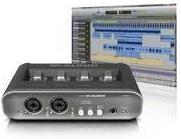
Recording Software
CoolEdit v2 - v2001
I started using this when it was in its infancy, back in 1995. In 1996, at a multimedia conference in Orlando, I had the priviledge of meeting the developer who designed the filters for the program. It was really cool to talk shop and learn some of the math behind what I had been using for a while. It was single-track, at that point, and I learned all about "Paste Into" and trying to line up sound files by hand. "Ugly" about covers it.
The first multi-track software I used was CoolEditPro and I still use it, every so often, today, even though it was purchased by Adobe and, in a lot of ways, hosed up in the form of Audition. There was a simplicity to the program that I enjoyed.
Cakewalk v5
This software, for me, was one of the best for what I needed at the time. The way it handled drums on the staff notation was, at the time, second to none and even with GuitarPro's drum output being spotty, Cakewalk still holds its own, even if it is old enough to vote. In fact, the first "complete" song I wrote from beginning to end was possible with this. I put together the drums and bass line in CW, recorded it into the 4-track and hammered out the entire song in a day. The drums, coming through the SoundBlaster AWE64 card using soundfonts sounded pretty solid and it wasn't until the last couple of years that I was able to replicate what I was able to accomplish within this software package.
Reaper
I've gone through a number of DAW packages, really, from Cubase to ProTools and what I've found is that none of them do what I want for what Reaper does -- the bang for your buck ratio is exceedingly high. I kept it in "unlimited demo" mode for the entirety of mixing Brendan's album, originally because I was doing a side-by-side comparison with ProTools. The bottom line was Reaper won out -- lower CPU hammering, much lower price, all the same functionality (that I needed). So, if you've not tried Reaper, do so. The learning curve from the others to it aren't steep and the power to price ratio is fantastic.
1988 - 1995 - Ibanez DL-10 Delay
I loved this pedal, too, but like the CH1, it ate batteries with dark gusto. This was the pedal that was paired with the chorus specifically for a song intro that, like I said -- I haven't been able to recreate with effects processors... I think I parted ways with this after I got the Quadraverb as, if I recall, something bad happened, internally, and that ozone smell that indicates something electronic has died.


